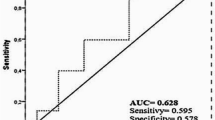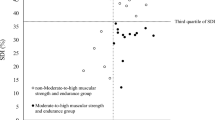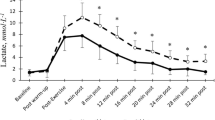Abstract
Introduction
Monitoring muscle metabolic activity via blood lactate is a useful tool for understanding the physiological response to a given exercise intensity. Recent indications suggest that skeletal muscle oxygen saturation (SmO2), an index of the balance between local O2 supply and demand, may describe and predict endurance performance outcomes.
Purpose
We tested the hypothesis that SmO2 rate is tightly related to blood lactate concentration across exercise intensities, and that deflections in SmO2 rate would coincide with established blood lactate thresholds (i.e., lactate thresholds 1 and 2).
Methods
Ten elite male soccer players completed an incremental running protocol to exhaustion using 3-min work to 30 s rest intervals. Blood lactate samples were collected during rest and SmO2 was collected continuously via near-infrared spectroscopy from the right and left vastus lateralis, left biceps femoris and the left gastrocnemius.
Results
Muscle O2 saturation rate (%/min) was quantified after the initial 60 s of each 3-min segment. The SmO2 rate was significantly correlated with blood lactate concentrations for all muscle sites; RVL, r = − 0.974; LVL, r = − 0.969; LG, r = − 0.942; LHAM, r = − 0.907. Breakpoints in SmO2 rate were not significantly different from LT1 or LT2 at any muscle sites (P > 0.05). Bland–Altman analysis showed speed threshold estimates via SmO2 rate and lactate are similar at LT2, but slightly greater for SmO2 rate at LT1.
Conclusions
Muscle O2 saturation rate appears to provide actionable information about maximal metabolic steady state and is consistent with bioenergetic reliance on oxygen and its involvement in the attainment of metabolic steady state.





Similar content being viewed by others
Data availability
The authors confirm that the data supporting the findings of this study are available within the article and will be made available from the corresponding author on reasonable request.
References
Agbangla NF, Audiffren M, Albinet CT (2017) Assessing muscular oxygenation during incremental exercise using near-infrared spectroscopy: comparison of three different methods. Physiol Res 66(6):979–985. https://doi.org/10.33549/physiolres.933612
Azevedo RD, JE, B. S., Inglis, E. C., Iannetta, D., & Murias, J. M. (2020) Hypoxia equally reduces the respiratory compensation point and the NIRS-derived [HHb] breakpoint during a ramp-incremental test in young active males. Physiol Rep 8(12):e14478
Barstow TJ (2019) Understanding near infrared spectroscopy and its application to skeletal muscle research. J Appl Physiol 126(5):1360–1376
Batterson PM, Norton MR, Hetz SE, Rohilla S, Lindsay KG, Subudhi AW, Jacobs RA (2020) Improving biologic predictors of cycling endurance performance with near-infrared spectroscopy derived measures of skeletal muscle respiration: E pluribus unum. Physiol Rep 8(2):e14342. https://doi.org/10.14814/PHY2.14342
Bernal-Orozco MF, Posada-Falomir M, Quiñónez-Gastélum CM, Plascencia-Aguilera LP, Arana-Nuño JR, Badillo-Camacho N, Márquez-Sandoval F, Holway FE, Vizmanos-Lamotte B (2020) Anthropometric and body composition profile of young professional soccer players. J Strength Cond Res 34(7):1911
Boone J, Barstow TJ, Celie B, Prieur F, Bourgois J (2016) The interrelationship between muscle oxygenation, muscle activation, and pulmonary oxygen uptake to incremental ramp exercise: Influence of aerobic fitness. Appl Physiol Nutr Metab 41(1):55–62
Brooks GA (2020) Lactate as a fulcrum of metabolism. Redox Biol 35:101454
Caen K, Vermeire K, Bourgois JG, Boone J (2018) Exercise thresholds on trial: are they really equivalent? Med Sci Sports Exerc 50(6):1277–1284
Caen K, Bourgois JG, Stassijns E, Boone J (2022) A longitudinal study on the interchangeable use of whole-body and local exercise thresholds in cycling. Eur J Appl Physiol 122(7):1657–1670
Caen, K., & Boone, J. (2023) Response to Goulding et al.(2022): Are whole-body and local thresholds mechanistically linked? European Journal of Applied Physiology, 123(2), 421–422.
Carter H, Pringle JS, Jones AM, Doust JH (2002) Oxygen uptake kinetics during treadmill running across exercise intensity domains. Eur J Appl Physiol 86(4):347–354
Celie B, Boone J, Coster RV, Bourgois J (2012) Reliability of near infrared spectroscopy (NIRS) for measuring forearm oxygenation during incremental handgrip exercise. Eur J Appl Physiol 112(6):2369–2374. https://doi.org/10.1007/S00421-011-2183-X/TABLES/2
Chuang ML, Ting H, Otsuka T, Sun XG, Chiu FYL, Hansen JE, Wasserman K (2002) Muscle deoxygenation as related to work rate. Med Sci Sports Exerc 34(10):1614–1623. https://doi.org/10.1097/00005768-200210000-00013
Davis JA, Whipp BJ, Lamarra N, Huntsman DJ, Frank MH, Wasserman K (1982) Effect of ramp slope on determination of aerobic parameters from the ramp exercise test. Med Sci Sports Exerc 14(5):339–343
Donovan CM, Brooks GA (1983) Endurance training affects lactate clearance, not lactate production. Am J Physiol-Endocrinol Metabol. https://doi.org/10.1152/AJPENDO.1983.244.1.E83
Faude O, Kindermann W, Meyer T (2009) Lactate threshold concepts: How valid are they? Sports Med 39(6):469–490. https://doi.org/10.2165/00007256-200939060-00003
Feldmann A, Erlacher D (2021) Critical oxygenation: can muscle oxygenation inform us about critical power? Med Hypotheses 150:110575
Feldmann A, Schmitz RW, Erlacher D (2019) Near-infrared spectroscopy-derived muscle oxygen saturation on a 0% to 100% scale: reliability and validity of the Moxy monitor. J Biomed Opt 24(11):115001
Galán-Rioja MÁ, González-Mohíno F, Poole DC, González-Ravé JM (2020) Relative proximity of critical power and metabolic/ventilatory thresholds: systematic review and meta-analysis. Sports Med 50(10):1771–1783
Goulding RP, Marwood S, Lei T-H, Okushima D, Poole DC, Barstow TJ, Kondo N, Koga S (2021) Dissociation between exercise intensity thresholds: Mechanistic insights from supine exercise. Am J Physiol Regul, Integr Compar Physiol 321(5):R712–R722
Goulding RP, Marwood S, Lei T-H, Okushima D, Poole DC, Barstow TJ, Kondo N, Koga S (2023) Time to retire the notion that local and whole-body exercise thresholds are mechanistically linked? Eur J Appl Physiol 123(2):419–420
Grassi B, Quaresima V, Marconi C, Ferrari M, Cerretelli P (1999) Blood lactate accumulation and muscle deoxygenation during incremental exercise. J Appl Physiol 87(1):348–355
Iannetta D, Qahtani A, Maturana FM, Murias JM (2017) The near-infrared spectroscopy-derived deoxygenated haemoglobin breaking-point is a repeatable measure that demarcates exercise intensity domains. J Sci Med Sport 20(9):873–877
Iannetta D, Passfield L, Qahtani A, MacInnis MJ, Murias JM (2019) Interlimb differences in parameters of aerobic function and local profiles of deoxygenation during double-leg and counterweighted single-leg cycling. Am J Physiol-Regul, Integr Compar Physiol 317(6):R840–R851
Iannetta, D., Ingram, C. P., Keir, D. A., & Murias, J. M. (2021) Methodological reconciliation of CP and MLSS and their agreement with the maximal metabolic steady state. Medicine and Science in Sports and Exercise.
Jamnick NA, Botella J, Pyne DB, Bishop DJ (2018) Manipulating graded exercise test variables affects the validity of the lactate threshold and V˙ O 2 peak. PLoS ONE 13(7):e0199794
Jones AM, Burnley M, Black MI, Poole DC, Vanhatalo A (2019) The maximal metabolic steady state: redefining the gold standard. Physiol Rep 7(10):e14098. https://doi.org/10.14814/phy2.14098
Joyner MJ, Coyle EF (2008) Endurance exercise performance: the physiology of champions. J Physiol 586(1):35–44. https://doi.org/10.1113/JPHYSIOL.2007.143834
Keir DA, Fontana FY, Robertson TC, Murias JM, Paterson DH, Kowalchuk JM, Pogliaghi S (2015) Exercise intensity thresholds: identifying the boundaries of sustainable performance. Med Sci Sports Exerc 47(9):1932–1940
Kirby BS, Clark DA, Bradley EM, Wilkins BW (2021) The balance of muscle oxygen supply and demand reveals critical metabolic rate and predicts time to exhaustion. J App Physiol 130(6):1915–1927. https://doi.org/10.1152/JAPPLPHYSIOL.00058.2021
Nixon RJ, Kranen SH, Vanhatalo A, Jones AM (2021) Steady-state ̇ V O _ 2 V˙ O 2 above MLSS: evidence that critical speed better represents maximal metabolic steady state in well-trained runners. Eur J Appl Physiol 121:3133–3144
Okushima D, Poole DC, Barstow TJ, Rossiter HB, Kondo N, Bowen TS, Amano T, Koga S (2016) Greater VO2peak is correlated with greater skeletal muscle deoxygenation amplitude and hemoglobin concentration within individual muscles during ramp-incremental cycle exercise. Physiol Rep 4(23):e13065
Ozkaya O, Balci GA, As H, Cabuk R, Norouzi M (2022) Grey zone: a gap between heavy and severe exercise domain. J Strength Cond Res 36(1):113–120
Perrey S, Ferrari M (2018) Muscle oximetry in sports science: a systematic review. Sports Med 48(3):597–616
Piatrikova E, Sousa AC, Willsmer NJ, Gonzalez JT, Williams S (2020) Demarcating exercise intensity domains in freestyle swimming: is there an alternative to incremental step test and beats below HRmax method? J Strength Condition Res 34(9):2575–2584
Pilotto AM, Adami A, Mazzolari R, Brocca L, Crea E, Zuccarelli L, Pellegrino MA, Bottinelli R, Grassi B, Rossiter HB (2022) Near-infrared spectroscopy estimation of combined skeletal muscle oxidative capacity and O2 diffusion capacity in humans. J Physiol 600(18):4153–4168
Płoszczyca K, Jazic D, Piotrowicz Z, Chalimoniuk M, Langfort J, Czuba M (2020) Comparison of maximal lactate steady state with anaerobic threshold determined by various methods based on graded exercise test with 3-minute stages in elite cyclists. BMC Sports Sci Med Rehabil 12(1):1–9. https://doi.org/10.1186/S13102-020-00219-3/FIGURES/1
Poole DC, Ward SA, Gardener GW, Whipp BJ (1988) Metabolic and respiratory profile of the upper limit for prolonged exercise in man. Ergonomics 31(9):1265–1279
Poole DC, Kindig CA, Behnke BJ, Jones AM (2005) Oxygen uptake (VO2) kinetics in different species: a brief review. Equine Compar Exer Physiol 2(1):1–15
Poole DC, Rossiter HB, Brooks GA, Gladden LB (2021) The anaerobic threshold: 50+ years of controversy. Journal of Physiology). Blackwell Publishing Ltd, Hobooken, pp 737–767
Ryan TE, Southern WM, Reynolds MA, McCully KK (2013) A cross-validation of near-infrared spectroscopy measurements of skeletal muscle oxidative capacity with phosphorus magnetic resonance spectroscopy. J Appl Physiol 115(12):1757–1766
Ryan TE, Brophy P, Lin C, Hickner RC, Neufer PD (2014) Assessment of in vivo skeletal muscle mitochondrial respiratory capacity in humans by near-infrared spectroscopy: a comparison with in situ measurements. J Physiol 592(15):3231–3241
Smith CG, Jones AM (2001) The relationship between critical velocity, maximal lactate steady-state velocity and lactate turnpoint velocity in runners. Eur J Appl Physiol 85(1):19–26
Snyder AC, Parmenter MA (2009) Using near-infrared spectroscopy to determine maximal steady state exercise intensity. J Strength Cond Res 23(6):1833–1840. https://doi.org/10.1519/JSC.0b013e3181ad3362
Spencer MD, Murias JM, Paterson DH (2012) Characterizing the profile of muscle deoxygenation during ramp incremental exercise in young men. Eur J Appl Physiol 112(9):3349–3360
Wang B, Xu G, Tian Q, Sun J, Sun B, Zhang L, Luo Q, Gong H (2012) Differences between the Vastus Lateralis and Gastrocnemius Lateralis in the assessment ability of breakpoints of muscle oxygenation for aerobic capacity indices during an incremental cycling exercise. J Sports Sci Med 11(4):606–613
Yogev A, Arnold J, Clarke D, Guenette JA, Sporer BC, Koehle MS (2022) Comparing the respiratory compensation point with muscle oxygen saturation in locomotor and non-locomotor muscles using wearable nirs spectroscopy during whole-body exercise. Front Physiol 13:483. https://doi.org/10.3389/fphys.2022.818733
Acknowledgements
We would like to thank all the participants, and Medbase Sportsmedical Center Abtwil for their support and expertise. We would like to thank Simon Storm for his support and openness. We would like to thank Linda Ammann for all her effort and support in making this project possible. The results of the study are presented clearly, honestly, and without fabrication, falsification, or inappropriate data manipulation, and statement that results of the present study do not constitute endorsement by ACSM.
Funding
The authors report no funding for the collection or preparation of this manuscript.
Author information
Authors and Affiliations
Contributions
GH, and AF designed study and performed experiments. PMB, BK, and AF performed the analysis and drafted the manuscript. PMB, BSK, and AF edited the manuscript.
Corresponding author
Ethics declarations
Conflict of interest
Dr. Feldmann is a minority shareholder of, and professional contributor to Fortiori Designs LLC, the company that manufactures and distributes the NIRS device used in this study. Mr. Batterson is a professional contributor to Fortiori Designs LLC.
Additional information
Communicated by I. Mark Olfert.
Publisher's Note
Springer Nature remains neutral with regard to jurisdictional claims in published maps and institutional affiliations.
Rights and permissions
Springer Nature or its licensor (e.g. a society or other partner) holds exclusive rights to this article under a publishing agreement with the author(s) or other rightsholder(s); author self-archiving of the accepted manuscript version of this article is solely governed by the terms of such publishing agreement and applicable law.
About this article
Cite this article
Batterson, P.M., Kirby, B.S., Hasselmann, G. et al. Muscle oxygen saturation rates coincide with lactate-based exercise thresholds. Eur J Appl Physiol 123, 2249–2258 (2023). https://doi.org/10.1007/s00421-023-05238-9
Received:
Accepted:
Published:
Issue Date:
DOI: https://doi.org/10.1007/s00421-023-05238-9




